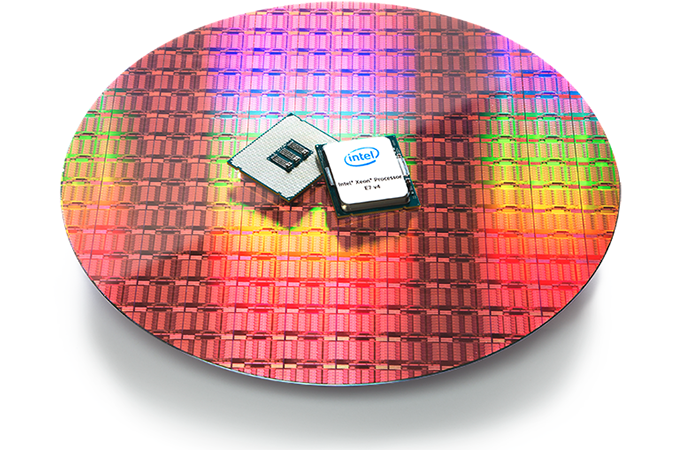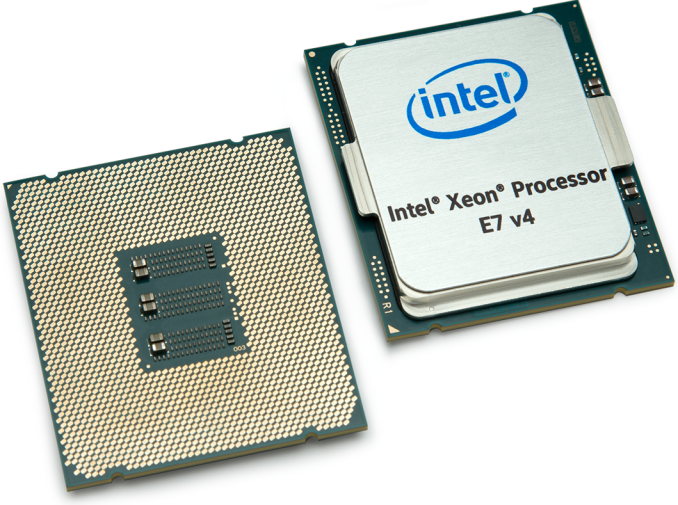Intel Announces the Xeon E7-8894 v4 CPU: 24 Cores at 2.4 GHz for $8898
by Anton Shilov on February 13, 2017 9:00 AM EST- Posted in
- CPUs
- Intel
- Xeon
- Servers
- Broadwell-EX
- E7-8894 v4

In the past week, Intel has launched a new halo CPU - its highest-performing multi-core CPU for multi-socket mission-critical servers, the Xeon E7-8894 v4. The new processor is based on the Broadwell-EX die and has approximately a 200 MHz higher base frequency than its direct predecessor, released in Q2 2016. Intel said that the new CPU has set a number of records in various benchmarks. Intel’s customers interested in the chip will also have to pay a record price too.
The flagship Intel Xeon E7-8894 v4 processor features the Broadwell-EX XCC (extreme core-count) die and has 24 cores with Hyper-Threading technology, 60 MB of L3 cache, 165 W TDP, a default frequency of 2.4 GHz and a turbo frequency of up to 3.4 GHz. Like other Broadwell-EX XCC CPUs, the new chip has quad-channel DDR3/DDR4 memory controller support and can manage up to ~3 TB of DRAM per socket (when used in conjunction with four Jordan Creek 2 scalable memory buffers). The CPUs are also equipped with 32 PCIe 3.0 lanes and three 9.6 GT/s QPI links for multi-socket environments.
| Intel E7-8800 v4 Xeon Family | ||||||||
| E7-8867 v4 | E7-8870 v4 | E7-8880 v4 | E7-8890 v4 | E7-8894 v4 |
E7-8891 v4 | E7-8893 v4 | ||
| TDP | 165 W | 140 W | 150 W | 165 W | 165 W | 140 W | ||
| Cores | 18 / 36 | 20 / 40 | 22 / 44 | 24 / 48 | 10 / 20 | 4 / 8 | ||
| Base Freq | 2400 | 2100 | 2200 | 2200 | 2400 | 2800 | 3200 | |
| Turbo | 3300 | 3000 | 3300 | 3400 | 3500 | 3500 | ||
| L3 Cache | 45 MB | 50 MB | 55 MB | 60 MB | 60 MB | 60 MB | ||
| QPI (GT/s) | 3 × 9.6 | 3 x 9.6 | 3 x 9.6 | |||||
| DRAM | DDR4-1866 DDR3-1600 |
DDR4-1866 DDR3-1600 |
||||||
| PCIe | PCIe 3.0 x32 | 3.0 x32 | 3.0 x32 | |||||
| Price | $4672 | $4762 | $5895 | $7174 | $8898 | $6841 | $6841 | |
Intel’s multi-core Xeon E7 processors are designed for various heavy-duty servers with four, eight or more sockets (to support more than eight sockets special third-party node controllers are required). Such mission-critical machines typically to be available 24/7/365 and this is why the Xeon E7 v4 and the Broadwell-EX range has a host of various RAS (reliability, availability, serviceability) features. The Xeon E7-8894 v4 CPU has exactly the same set of capabilities as its direct predecessor, the Xeon E7-8890 v4 released last year.
Intel claims that due to increased default frequency (and obviously because of the core count in general), the Xeon E7-8894 v4 sets a number of performance records in various general, server, HPC, big data analytics, business processing, database and other benchmarks, such as SPECint_base2006, SPECompG_2012, and so on.
The Intel Xeon E7-8894 v4 processor carries a tray price of $8898, which is the highest price of an Intel mass-produced CPU ever. Its predecessor on the top spot in the range, the 24-core Xeon E7-8890 v4 (which runs at 2.2 GHz) is priced at $7174 and still sits at its original tray price. As always, there are customers willing to pay such sums of money for server CPUs that deliver certain levels of performance. Moreover, there are workloads that benefit from a +200MHz (9%) performance increase so significantly (from a financial point of view to the owners of the machines) that it justifies paying extra 24% (or $1724) for a 200 MHz frequency increase (provided that this is the only advantage that this CPU has over the E7-8890 v4).
| Intel Xeon E-Series Families (February 2017)* | |||||
| E3-1200 v5 | E3-1500 v5 | E5-1600 v4 E5-2600 v4 E5-4600 v4 |
E7-4800 v4 | E7-8800 v4 | |
| Core Family | Skylake | Skylake | Broadwell | Broadwell | Broadwell |
| Core Count | 2 to 4 | 2 to 4 | 4 to 22 | 8 to 16 | 4 to 24 |
| Integrated Graphics | Few, HD 520 | Yes, Iris Pro | No | No | No |
| DRAM Channels | 2 | 2 | 4 | 4 | 4 |
| Max DRAM Support (per CPU) | 64 GB | 64 GB | 1536 GB | 3072 GB | 3072GB |
| DMI/QPI | DMI 3.0 | DMI 3.0 | 2600: 1xQPI 4600: 1xQPI |
3 QPI | 3 QPI |
| Multi-Socket Support | No | No | 2600: 1S/2S 4600: 1S/2S |
1S, 2S or 4S | Up to 8S |
| PCIe Lanes | 16 | 16 | 40 | 32 | 32 |
| Cost | $213 to $612 |
$396 to $1207 |
$294 to $7007 |
$1223 to $3003 |
$4061 to $8898 |
| Suited For | Entry Workstations | QuickSync, Memory Compute |
High-End Workstation | Many-Core Server | World Domination |
*Intel also has the E3-1500M v5 and E3-1500M v6 mobile parts which are left out of this table
We've asked Intel to disclose the official per-core turbo numbers for comparison to their other chips, as well as a full range of DRAM support depending on memory type and memory density. We will update this news piece as we get more information.
Related Reading:
Source: Intel











83 Comments
View All Comments
joema - Wednesday, February 15, 2017 - link
"...typically, SPARC M7 is 2-3x faster than the fastest Intel Xeon or POWER8...I would be very surprised if Intel manages to snatch one single world record from SPARC M7 on a socket-per-socket basis"If the M7 is 2-3x faster than the fastest Xeon, why is it unable to produce TPC-E transaction processing performance that supports that claim? I don't see any SPARC machine in the top 10: http://www.tpc.org/tpce/results/tpce_perf_results.... even including the most recent results: http://www.tpc.org/tpce/results/tpce_last_ten_resu...
Kevin G - Tuesday, February 14, 2017 - link
Running VMs in a single box is indeed one of the major applications.Backend database workloads are another due to their massive memory capacity. Though high socket count is preferred for the memory capacity, often high core count isn't necessarily favored due to the per core licensing model of most enterprise database products.
Kevin G - Tuesday, February 14, 2017 - link
AMD actually had some good 4S traction and even some 8S systems back in the early days of the Opteron. Scaling via Hypertransport proved to be more efficient than the FSB topology used by Intel.Meteor2 - Wednesday, February 15, 2017 - link
AMD had a lot of HPC wins back in the Opteron day. I wonder if that was also because of Hypertransport? I guess Intel's Quick Path ticks that box nowadays.Krysto - Wednesday, February 22, 2017 - link
Eh, sure if you're talking about using 2 such CPUs or whatever. But think of all of major companies that do machine learning or offer cloud services. Those extra few thousand dollars per chip will add-up quickly.Ej24 - Monday, February 13, 2017 - link
I'm definitely waiting to hear more about Naples as well. So much hype around ryzen desktop which is great, but has anyone heard anything on Naples in a while?Freakie - Monday, February 13, 2017 - link
Not likely to ever happen. The highest end server CPU's tend to not hit crazy low price points because there just isn't enough volume. Not enough people will buy this CPU new for there to be enough to be dirt cheap in the used market in the future. The demand for used versions of this CPU will outstrip the supply.Anato - Monday, February 13, 2017 - link
They will go down to 0 at some point. When I was a teen in 90's there was old $100k servers as table or bench in lounge of local ham society.But bigger "problem" with these systems is, they don't come to second hand sale as companies worry about the data they may still contain so they are crushed to dust and not sold out.
HighTech4US - Monday, February 13, 2017 - link
Quote: They will go down to 0 at some point.At which point they actually have a value of zero because NO ONE wants them.
While they have value they will still have a price much higher than $50.
Example: Xeon W3690 (top of the line 2010 Westmere single socket workstation CPU) came to market in 2010 at $999. It still sells for $140 on eBay.
prisonerX - Monday, February 13, 2017 - link
Price and value are two different things, genius.The computer club at my alma matter were overjoyed when they received their free PDP-11, previously worth 6 figures.
Sure they had to punch opcodes into the front panel to get it to boot, but that's part of the fun, isn't it?